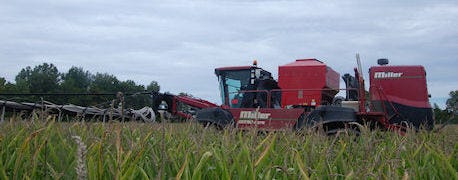
No one needs to convince Mike Shuter that cover crops work. He's already convinced. Now he's trying to fine-tune the system to get more benefit from the money and time invested in establishing a cover crop. His goal was to figure out how to get the cover crop seeded earlier than waiting for harvest.
That's why he and sons Patrick and Brian, Frankton, converted this Miller sprayer into a cover crop seeder for the fall season. Next spring it will become a sprayer again. They simply switch out the Gandy air seeder box for a sprayer tank and replace the plastic drop tubes with nozzles.

'GREEN' MACHINE: OK, this Miller sprayer is red. But its goal is to turn the field green with a growing cover crop, saving soil and also sucking up nitrogen which would otherwise end up in water supplies.
Well, maybe it's not quite that simple. But the Shuters have figured out how to use the machine for both purposes. While they rigged it up last year, Shuter intends to cover more acres this year. He's also moved up the seeding date. He had a good percentage of his corn land seeded before Labor Day.
He seeds a bushel of cereal rye per acre into standing corn if he's going to soybeans in that field next year. The drop tubes sway enough on their own to help distribute the seed across the row area. The drops are on 30-inch centers across the 90-foot boom.
If he's going into a cornfield that will be in corn again next year, he's seeding a different mixture. He's seeding 20 pounds per acre of annual ryegrass plus forage radishes and crimson clover. The crimson clover has the potential to help produce nitrogen next spring.
All the cover crops will help capture N this fall that's left behind after a sub-par crop. Once the N is captured by cover crops, it will begin to be released after the crops die or are killed by herbicide next spring. All the N that they take in may not be released for next year's crop, but at least the N will be saved and not lost through leaching into tile lines and tributaries.
About the Author(s)
You May Also Like




